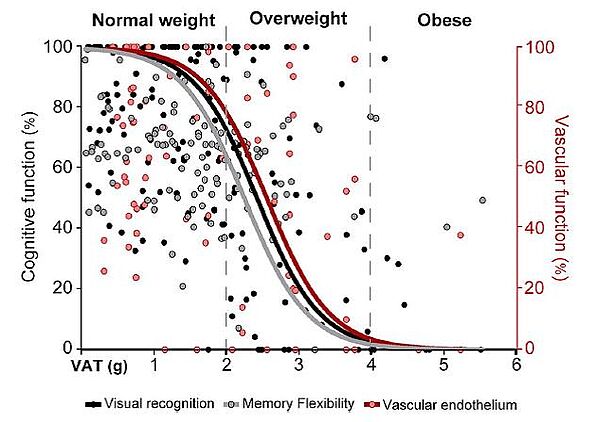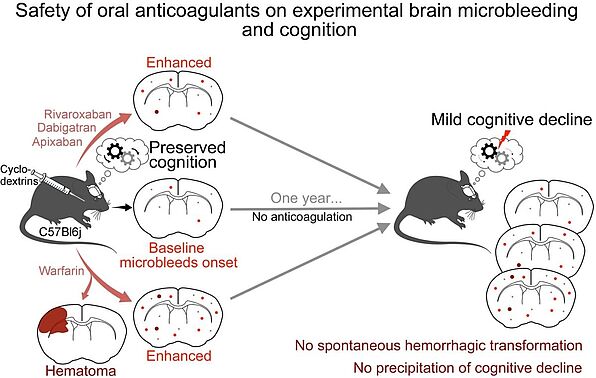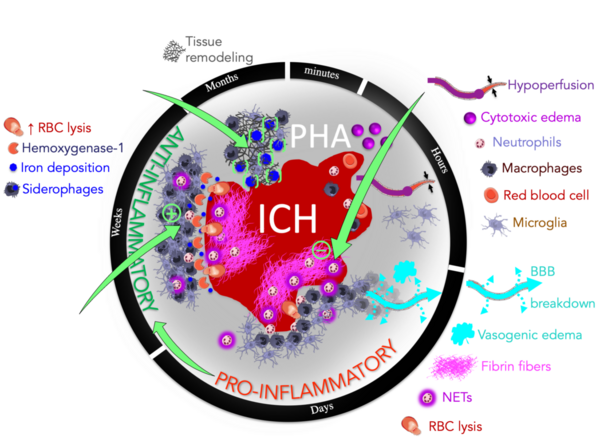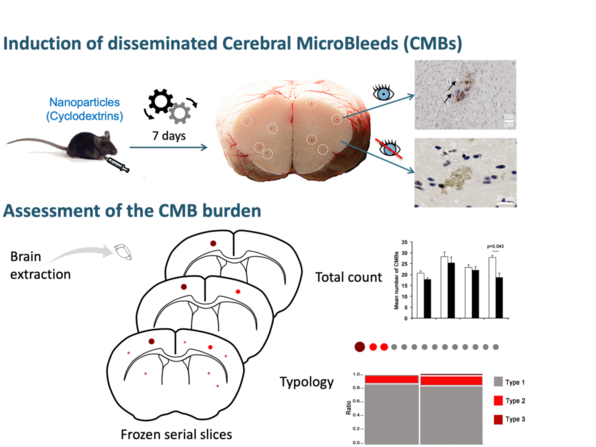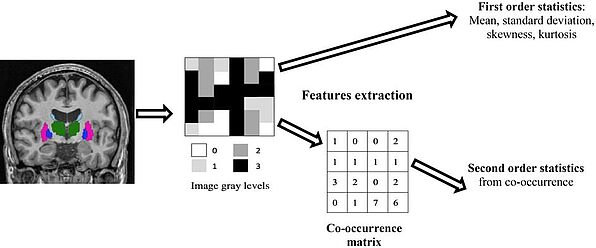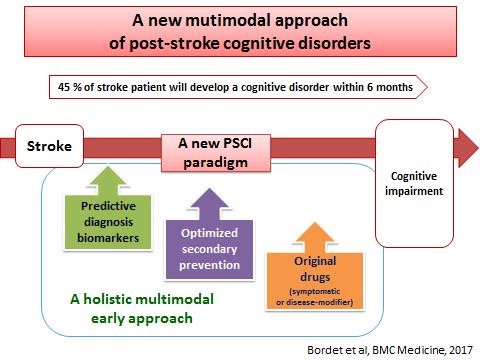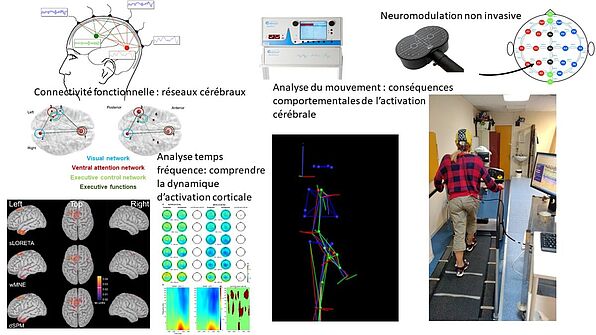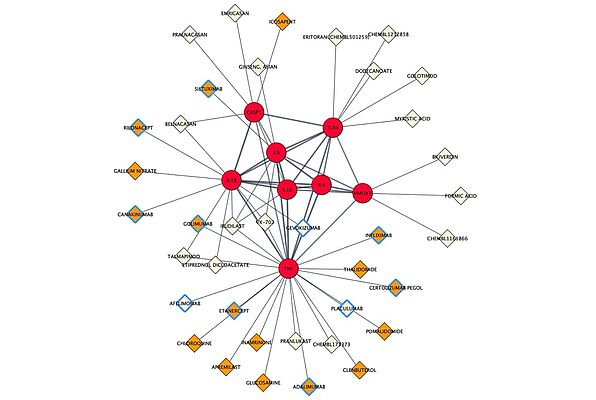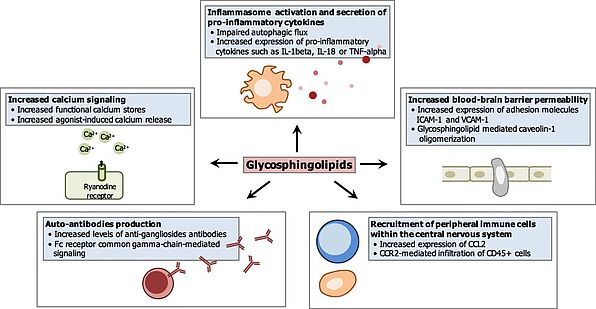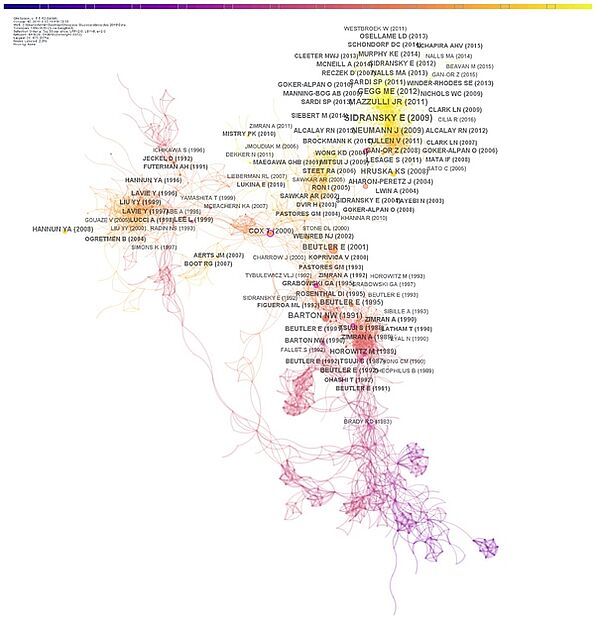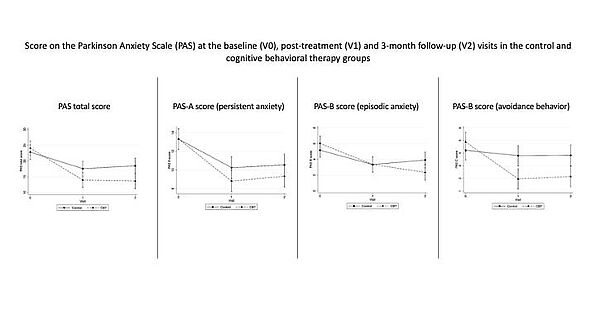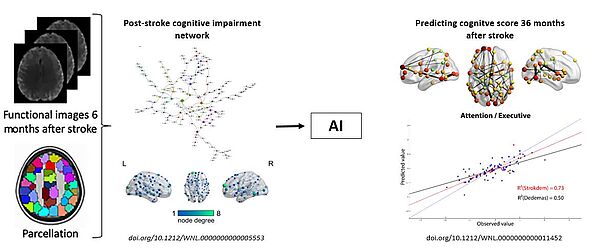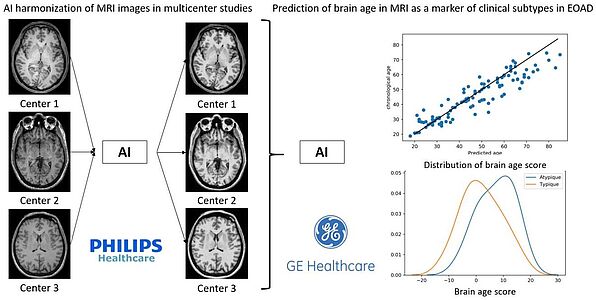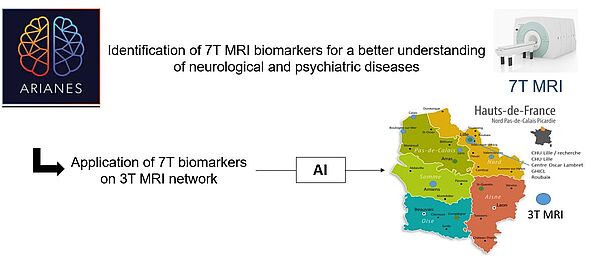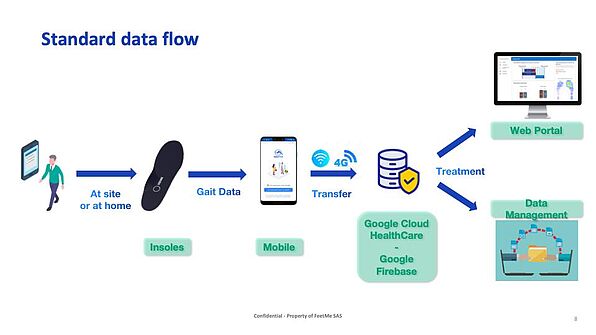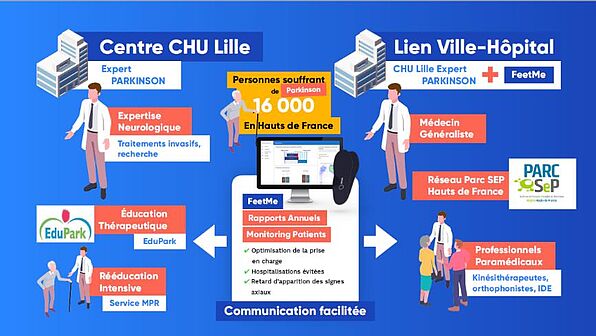Structuring projects
Leader Michèle Bastide
Project description
The presence of metabolic disorders in middle age is associated with a high risk of developing cognitive disorders in old age. In order to understand the pathophysiological mechanisms that predispose brain tissue to cognitive dysfunction, we developed a long-term mouse model that reproduces the progressive establishment of metabolic disorders in response to a high-fat diet. This model allowed the demonstration of cerebrovascular dysfunction associated with the development of metabolic disorders (visceral adiposity and prediabetes) and cognitive deficit. Thanks to the combination of behavioral assessment techniques, cerebrovascular exploration, electrophysiology and metabolic characterization, this project continues along 2 axes, (i) the study of the mechanisms involved in neurogliovascular uncoupling; (ii) the impact of pharmacological or nutraceutical modulation of metabolic disorders on cognitive deficit.
Team: Michèle Bastide, Olivier Petrault, Maud Petrault, Sandra Mouchref, Thavarak Ouk, Stéphanie Bombois, Vincent Berezowski, Patrick Gelé, Manon Haas.
Highlights
- Demonstration of the relationship between visceral adiposity, cerebrovascular dysfunction and occurrence of cognitive disorders in mid-life in a mouse model induced by diet (High-fat diet)
- Pharmacological and/or nutraceutical modulations of metabolic disorders: impact on cognitive disorders
- Development of a long-term mouse model of diet-induced metabolic disorders (High-fat diet)
Publications
Pétrault, O., Pétrault, M., Ouk, T., Bordet, R., Bérézowski, V., Bastide, M., 2019. Visceral adiposity links cerebrovascular dysfunction to cognitive impairment in middle-aged mice. Dis. 130, 104536.
Pétrault, M., Ouk, T., Bastide, M., Bordet, R., Pétrault, O., Bérézowski, V., 2021. Age and diet modify acute microhemorrhage outcome in the mouse brain. Neurobiol Aging 98, 107.
Leader Jean-Christophe Devedjian
Project description
Neurodegenerative diseases are multifactorial but are all characterized by the regulated death of neurons which, depending on their location, have variable clinical expressions. For a long time, the dogma of a single regulated death by apoptosis limited research. Among other forms, ferroptosis has recently been described and is characterized by iron dependence and an accumulation of peroxidized lipids at the membrane leading to its rupture. We demonstrated in vitro and in vivo that human dopamine neurons are particularly sensitive to ferroptosis and that specific inhibitors such as Ferrostatin-1, Liproxstatin-1 and iron chelators are potent neuroprotective agents.
We are currently working on the links with alpha synuclein, lipid metabolism and mitochondrial energy metabolism while developing specific biomarkers and new molecules and large therapeutic trials.
Team: Jean Christophe Devedjian, David Devos, Caroline Moreau, Anne Sophie Rolland, Pauline Guyon, Charlotte Laloux, Flore Gouel, Kelly Timmerman, Cédrick Lachaud, Aurélie Jonneaux, Maud Petrault, Laura Mahoney-Sanchez, Hind Bouchaoui, Karim Belarbi, Marie Amandine Bonte, Emma Theerens, Florent Auger, Clemence Leboullenger, Renaud Lopes, Nacim Betrouni, Jean Pierre Pruvo, Gregory Kuchcinski, Romain Viard, Véronique Danel Luc Defebvre, Dominique Deplanque, Régis Bordet
Lille Collaborations:
UMRS 1172 Vincent Huin (team A&T), Patricia Melnyk, Séverine Ravez, Jamal El Bakali (team BBC)
ULR4483 - IMPact de l'Environnement Chimique sur la Santé (IMPECS) : Guillaume Garçon
UMR9020 – UMR-S 1277: Philippe Marchetti, Jérome Kluza
Internationales Collaborations:
ALBORADA Drug Discovery Institute, University of Cambridge, UK: James Duce
Melbourne Dementia Research Centre, The Florey Institute of Neuroscience & Mental Health, The University of Melbourne, Australia: Ashley Bush, Scott Ayton
University of Munich Helmholtz Zentrum Muenchen Germany: Marcus Conrad
University of Ulm Germany: Markus Otto, Patrick Oeckl, Deniz Yilmazer-Hanke, Volker RascheA&M Della Pergola Chair in Life Sciences, Alexander Silberman Institute of Life Sciences, Hebrew University of Jerusalem, Israel 91904: Ioav Cabantchik
Consortium Européen FAIRPARK-II https://www.fairpark2.eu/
Industrial collaborations with contracts:
Iron chelators:Apopharma/Chiesi, Alterity, Abfero
Antiferroptotics : PTC Therapeutics
Labels/financing:
- 3 PHRC-Nationaux dont FAIR-ALS-II Conservative Iron Chelation by Deferiprone as a Disease-modifying Strategy for Amyotrophic Lateral Sclerosis using a multicentre, Parallel-group, Placebo-controlled, Randomized Clinical Trial on 240 patients Protocol ID: 2017-003763-35; ClinicalTrials.gov: NCT03293069.
- Patient associations (ARSLA, France Parkinson)
- European Commission Horizon 2020, grant agreement N° 633190 Conservative iron chelation as a disease-modifying strategy in Parkinson’s disease: a multicentre, parallel-group, placebo-controlled, randomized clinical trial of deferiprone (FAIR-PARK-II); Protocol ID: 2015_22; Clinical trial: NCT02655315
- European funds for preclinical research of excellence on neurodegenerative diseases: Network of Centres of Excellence in Neurodegeneration (CoEN) 2017-2018: Pathfinder III: Is prion like propagation of alpha synuclein aggregation associated with a ferroptotic cell death; PRION-IRON
- European Commission Horizon 2020 Eurostar for preclinical research: PD-IRONSYN, Novel Parkinson's Disease therapy targeting iron-related cell death and alpha synuclein aggregation
Highlights
3 Grants from the European Commission (H2020) including 2 preclinical and 1 clinical
- Centers of excellence in neurodegeneration: Prion-like propagation of ∝-synuclein and ferroptosis
- Eurostar: New therapy targeting ferroptosis and ∝-synuclein aggregation
- Clinical trial: Neuroprotection by conservative iron chelation in Parkinson's: randomized, multicenter, parallel-group clinical trial, deferiprone versus placebo https://www.fairpark2.eu/
New biomarkers and new treatments: Iron overload and massive lipid peroxidation offer new biomarkers by imaging and biology which make it possible to better define populations having a ferroptotic process and to monitor therapeutic effectiveness to facilitate the development of new chelators ( Abfero, Alterity) or even deferiprone in ALS (FAIRALS study).
Drug discovery : Enrichment with polyunsaturated fatty acids sensitizes ferroptosis. Inhibition of enzymes involved in lipid metabolism (ACSL4 and LOX15) prevents lipid peroxidation and cell death. The variation in ∝-synuclein levels modulates sensitivity to ferroptosis but not to other forms of cell death offering new therapeutic targets (LOX15 inhibitors, PTC Therapeutics) and new molecules (co-development Lille and Cambridge).
Publications
Ferroptosis, a newly characterized form of cell death in Parkinson's disease that is regulated by PKC. Do Van B, Gouel F, Jonneaux A, Timmerman K, Gelé P, Pétrault M, Bastide M, Laloux C, Moreau C, Bordet R, Devos D, Devedjian JC. Neurobiol Dis. 2016 doi: 10.1016/j.nbd.2016.05.011.
Ferroptosis and its potential role in the physiopathology of Parkinson's Disease. Mahoney-Sanchez L, Bouchaoui H, Ayton S, Devos D, Duce JA, Devedjian JC. Prog Neurobiol. 2021 doi: 10.1016/j.pneurobio.2020.101890.
Iron as a therapeutic target for Parkinson's disease. Moreau C, Duce JA, Rascol O, Devedjian JC, Berg D, Dexter D, Cabantchik ZI, Bush AI, Devos D. Mov Disord. 2018 doi: 10.1002/mds.27275.
Leader Vincent Berezowski
Project Description
Massive entry of blood into the brain can be a life-threatening event for people of any age. No specific treatment exists to date. And survivors experience a decline in cognitive function. Even microscopic hemorrhages, when there are several of them, no longer appear as minor lesions for the elderly. This project brings together neurologists and scientists to understand the tissue and functional consequences of cerebral hemorrhages, both macroscopic and microscopic, and to evaluate the influence of vascular risk factors and anticoagulant treatments. The choice was made for a translational approach combining clinical and neuropathological studies, but also imaging and innovative experimental models.
Team : Maud PETRAULT, Laurent PUY, Manon HAAS, Giuseppe SCOPELLITI, Antoine RAUCH, Olivier PETRAULT, Barbara CASOLLA, Marco PASI, Patrick GELE, François CAPARROS, Thavarak OUK, Michèle BASTIDE, Charlotte CORDONNIER, Vincent BEREZOWSKI.
Highlights
- Microhemorrhages have their own deleterious effect on cognition even in healthy mice in middle age, but this effect is not aggravated by direct oral anticoagulants or hypercholesterolemia.
- In humans, NETs (neutrophil extracellular traps) interact with hemostasis in intracerebral hematoma (ICH), and a new natural history of neuroinflammation in the perihematoma area (PHA), opening potential therapeutic targets (green) .
- Development of a unique model of disseminated cerebral microhemorrhages induced by nanoparticles in mice.
Publications
Brain Peri-Hematomal Area, a Strategic Interface for Blood Clearance: A Human Neuropathological and Transcriptomic Study. Puy L, Perbet R, Figeac M, Duchêne B, Deramecourt V, Cordonnier C, Bérézowski V. Stroke. doi: 10.1161/STROKEAHA.121.037751. Epub ahead of print. PMID: 35465695, 2022.
Neutrophil Extracellular Traps (NETs) infiltrate hematoma and surrounding brain tissue after intracerebral hemorrhage: a post-mortem study. Puy L, Corseaux D, Perbet R, Deramecourt V, Cordonnier C, Bérézowski V. Neuropathol Appl Neurobiol. 47:867-877, 2021.
Age and diet modify acute microhemorrhage outcome in the mouse brain. Pétrault M, Ouk T, Bastide M, Bordet R, Pétrault O, Bérézowski V. Neurobiol Aging 98 :99-107, 2021.
Safety of oral anticoagulants on experimental brain microbleeding and cognition. Pétrault M, Ouk T, Pétrault O, Bastide M, Bordet R, Bérézowski V. Neuropharmacology. 155:162-172, 2019.
Cerebral microbleeds: Beyond the macroscope. Pétrault M, Casolla B, Ouk T, Cordonnier C, Bérézowski V. Int J Stroke. 14:468-475, 2019.
Leader Nacim Betrouni
Project Description
In neurodegenerative diseases, imaging plays an important role in decision-making. Classic markers are based on the quantification of structural modifications. The NeuroRadioMics project hypothesizes that measuring signal variations, using different statistics, makes it possible to highlight modifications that would be early in the morphological change. This hypothesis was tested under different conditions with patient cohorts developed by colleagues. Thus, the method has proven effective in highlighting post-stroke cognitive decline. In addition, a study using a preclinical model of stroke showed that these measurements reflect tissue changes. In Parkinson's disease, these markers have been shown to correlate with motor or cognitive disorders
We are currently working on a better understanding of these markers through anatomo-pathological correlation studies.
Team: Nacim Betrouni, Chirine El Katrib
Collaborators: Charlotte Laloux, Régis Bordet, David Devos, Kathy Dujardin, Luc Defebvre, Caroline Moreau, Thibaut Dondaine, Anne-Sophie Rolland, Florent Auger, Maud Petrault, Grégory Kuchcinski, Jean-Pierre Pruvo, Renaud Lopes, Romain Viard
Highlights
- Patent filing on the concept of radio-biopsy: virtual biopsy in degenerative diseases (WO2019170711A1 METHOD FOR EARLY PREDICTION OF NEURODEGENERATIVE DECLINE), 2019
- Support from the University of Lille through the Innovation Quality Bonus for the development of a proof of concept for the project. 2020-2021.
- Establishment of an international multicenter study, thanks to the support of the STROKOG consortium, to test the method in the early detection of post-stroke cognitive disorders. 2021.
Publications
Betrouni N, Moreau C, Rolland AS, Carrière N, Chupin M, Kuchcinski G, Lopes R, Viard R, Defebvre L, Devos D. Texture-based markers from structural imaging correlate with motor handicap in Parkinson's disease. Sci Rep. 2021 Feb 1;11(1):2724. doi: 10.1038/s41598-021-81209-4.
Betrouni N, Lopes R, Defebvre L, Leentjens AFG, Dujardin K. Texture features of magnetic resonance images: A marker of slight cognitive deficits in Parkinson's disease. Mov Disord. 2020 Mar;35(3):486-494. doi: 10.1002/mds.27931.
Betrouni N, Yasmina M, Bombois S, Pétrault M, Dondaine T, Lachaud C, Laloux C, Mendyk AM, Henon H, Bordet R. Texture Features of Magnetic Resonance Images: an Early Marker of Post-stroke Cognitive Impairment. Transl Stroke Res. 2020 Aug;11(4):643-652. doi: 10.1007/s12975-019-00746-3.
Leader Anne-Sophie Rolland
Project Description
After decades of research, neurodegenerative diseases such as Parkinson's disease (PD) and amyotrophic lateral sclerosis (ALS) still lack neuroprotective treatment. This is based, at least in part, on the lack of reliable and sensitive biomarkers of disease severity and progression. Therefore, to develop new therapeutic approaches aimed at slowing or stopping disease progression, there is an unmet need to i) identify prognostic biomarkers to predict progression and stratify patients for more tailored and better care. quality and ii) to identify theragnostic biomarkers to predict effectiveness. of a given treatment. Due to the diversity of etiologies and multiple pathophysiological pathways involved in neurodegenerative diseases, it is crucial to perform reliable analysis of multiparametric biomarkers (clinical, biofluidics, imaging and genetics) to accurately predict disease progression. This project therefore aims to i) discover innovative biomarkers for PD and ALS using reliable animal models; and ii) translate their relevance to cohorts of patients with PD and ALS. To this end, we will analyze various biological markers such as miRNAs, perform unbiased proteomics, and obtain information on extracellular vesicles isolated from fluids to develop mathematical algorithms and artificial intelligence to provide multiparametric analysis and predictive models..
Partnership: this project will bring together transdisciplinary and transversal research teams
- Lil’N’Cog Center: Professor Devos team, Dr Blum team
- University of Lille: Department of Mathematics directed by Dr. Broustet, IMPECS laboratory directed by Dr. LoGuidice
- LIIFE platform in Lille: small animal and human imaging facilities
- Clinical proteomics platform in Montpellier led by Professor Hirtz
- Brain Institute: Aramis Dr Durrleman team
- Biomolecules Max Mousseron Institute (University of Montpellier): Dr Durand team
Highlights
- The combination of biological and genetic ferroptotic biomarkers can predict the severity, progression and outcome of Parkinson's disease. Article in preparation
- Regular caffeine consumption has no adverse effect on the phenotype and survival of ALS patients, but patients with a rare CYP1A1 SNP variant that impacts caffeine metabolism have a positive impact on the phenotype and survival of ALS patients. cognitive effect of caffeine on cognitive disorders. Article in preparation
- Using topological data analysis on diffusion MRI could predict the progression of Parkinson's disease. Preliminary results
Awards
- Hospital Fund of Lille University Hospital (2019): €30,000
- France Parkinson Association (2021): €60k
- PEPS AMIES theme (co-winner, 2023): €7k
Leader Régis Bordet
Contexte médical et scientifique
The occurrence of cognitive disorders following an ischemic stroke is now well known. The objective of the project is to identify predictive factors for the occurrence of these cognitive disorders, including for mild vascular accidents, and to characterize pharmacological approaches likely to prevent, improve or slow down the progression of these disorders. pharmacological. This project is carried out using a translational approach, combining animal models, cohort studies and interventional studies. The methodological tools combine biological markers, neuropsychological scales and brain imaging.
Team: Régis Bordet, Charlotte Cordonnier, Didier Leys, Dominique Deplanque, Hilde Hénon, Stéphanie Bombois, Thibaut Dondaine, Renault Lopes, Xavier Leclerc, Nacim Betrouni, Michèle Bastide, Maud Petrault, Thavarak Ouk, Cécile Bordier, Patrick Duriez, Christine Delmaire, Jean-Pierre Pruvo, Charlotte Laloux, Grégory Kuchcinski, Patrick Gelé
Internationals Collaborations: M Dichgans (Munich), Consortium Strokog (Australia), Consortium VCI Map PSCI (Utrecht) Strokavenir network
Industrials Collaborations: Theranexus, Metabrain Research, Qynapse, Axoltis, Kowa
Labels/financing: PHRC, FUI, Financement Industriel, Conseil Régional
Highlights
- In collaboration with the team of Martin Dichgans (Munich), we were able to show that strokes, without major motor consequences, were accompanied in 45% of cases by the occurrence of a cognitive disorder at 6 months.
- By combining an animal model and a cohort study, we showed that at 6 months, the occurrence of a cognitive disorder was associated with atrophy of the entorhinal cortex and deformation of the hippocampus.
- We identified a connectivity circuit that is altered in patients with post-stroke cognitive impairment, and the evolving nature of this alteration at 3 years.
- We have identified that the texture analysis of the hippocampus, measured by MRI at 72 hours after the occurrence of the stroke, can help predict the development of a post-stroke cognitive disorder.
- The STROKDEM cohort, which brings together 200 patients followed over 5 years, is a constituent cohort of several international consortia (Strokog, MICON, VCI map PSCI)
- One of the objectives of the CEOPS study is to study whether optimizing secondary prevention of stroke has an impact on the development of cognitive disorders.
Publications
Lopes R, Bournonville C, Kuchcinski G, Dondaine T, Mendyk AM, Viard R & al , Prediction of Long-term Cognitive Functions after Minor Stroke, Using Functional Connectivity., Neurology, 2021
Betrouni N, Yasmina M, Bombois S, Pétrault M, Dondaine T, Lachaud C & al , Texture Features of Magnetic Resonance Images: an Early Marker of Post-stroke Cognitive Impairment., Transl Stroke Res, 2019
Zietemann V, Georgakis MK, Dondaine T, Müller C, Mendyk AM, Kopczak A & al , Early MoCA predicts long-term cognitive and functional outcome and mortality after stroke., Neurology, 2018Bournonville C, Hénon H, Dondaine T, Delmaire C, Bombois S, Mendyk AM & al , Identification of a specific functional network altered in poststroke cognitive impairment., Neurology, 2018
Mendyk AM, Duhamel A, Bejot Y, Leys D, Derex L, Dereeper O & al , Controlled Education of patients after Stroke (CEOPS)-nurse-led multimodal and long-term interventional program involving a patient''s caregiver to optimize secondary prevention of stroke: study protocol for a randomized controlled trial, Trials, 2018
Delattre C, Bournonville C, Auger F, Lopes R, Delmaire C, Henon H & al , Hippocampal Deformations and Entorhinal Cortex Atrophy as an Anatomical Signature of Long-Term Cognitive Impairment: from the MCAO Rat Model to the Stroke Patient., Transl Stroke Res, 2017
Bordet R, Ihl R, Korczyn AD, Lanza G, Jansa J, Hoerr R & al , Towards the concept of disease-modifier in post-stroke or vascular cognitive impairment: a consensus report, BMC Med., 2017
Leader Louise Carton
Leader Arnaud Delval
Project Description
The neurophysiology project team aims to develop and use the neurophysiological tools (high-resolution electroencephalogram, non-invasive brain stimulation, movement analysis) necessary for the understanding and management of neurologically expressed diseases. More fundamental aspects aimed at better understanding brain functioning and developing relevant markers of a physiopathological process are also developed. The team is particularly interested in motor control and its interactions with cognitive impairment, whether in aging (impact on falls) or in central ganglia pathologies (Parkinson's disease), post-stroke, in dementia, epilepsy or in neuromuscular diseases. A final approach concerns decision-making medicine. This involves exploiting the physiological markers highlighted in cohort studies to facilitate their use in clinical routine. The work is based on the use of machine learning and big data approaches to build decision-making models going to the individual patient level and optimally combining the different markers.
Team : Nacim Betrouni et Philippe Derambure
Highlights
- Development of numerous collaborations in recent years at the Lille campus level (Cristal laboratory, François Cabestaing, development of brain-machine interfaces, Scalab, Cedrick Bonnet, posturographic aspects; Ali Amad and Arnaud Leroy, neuromodulation and behavioral disorders),
- at the regional level (ULCO, Hervé Devanne: modulation of cortical activity, plasticity and consequences on motor control)
- at a national level (University of Bordeaux, Professor Dominique Guehl, Professor Fabrice Wendling and Mahmoud Hassan (LTSI UMR Inserm University of Rennes))
- at an international level (University of Kiel, Christian Schlenstedt, University of Nijmegen, Bas Bloem, Claudio Babiloni (Department of Physiology and Pharmacology, University of Sapienza, Italy)…
- Implementation over the last 3 years of methods for analyzing functional connectivity in EEG
- Development of operational routines within the team to accommodate students with little training in signal processing (source analysis, evoked potentials, time-frequency analysis, connectivity)
- Technical platform allowing communication of tools (stimulation PC allowing administration of cognitive tests, high-resolution EEG, movement analysis system, neuromodulation systems, etc.)
Publications
Allali G, Blumen H, Devanne H, Pirondini E, Delval A, Van De Ville D. Brain imaging of locomotion in neurological conditions. Neurophysiol Clin 2018;48:337–59. https://doi.org/10.1016/j.neucli.2018.10.004.
Allart E, Delval A, Caux-Dedeystere A, Labreuche J, Viard R, Lopes R, et al. Parietomotor connectivity in the contralesional hemisphere after stroke: A paired-pulse TMS study. Clin Neurophysiol 2017;128:707–15. https://doi.org/10.1016/j.clinph.2017.02.016.
Allart E, Devanne H, Delval A. Contribution of transcranial magnetic stimulation in assessing parietofrontal connectivity during gesture production in healthy individuals and brain-injured patients. Neurophysiol Clin 2019;49:115–23. https://doi.org/10.1016/j.neucli.2018.12.005.
Allart E, Viard R, Lopes R, Devanne H, Delval A. Influence of Motor Deficiency and Spatial Neglect on the Contralesional Posterior Parietal Cortex Functional and Structural Connectivity in Stroke Patients. Brain Topogr 2020;33:176–90. https://doi.org/10.1007/s10548-019-00749-1.
Barthel C, van Helvert M, Haan R, Janssen A, Delval A, de Vries N, et al. Visual cueing using laser shoes reduces freezing of gait in Parkinson’’s patients at home. Mov Disord 2018a;33:1664–5. https://doi.org/10.1002/mds.27455.
Barthel C, Nonnekes J, van Helvert M, Haan R, Janssen A, Delval A, et al. The laser shoes: A new ambulatory device to alleviate freezing of gait in Parkinson disease. Neurology 2018b;90:e164–71. https://doi.org/10.1212/WNL.0000000000004795.
Bayot M, Delval A, Moreau C, Defebvre L, Hansen C, Maetzler W, et al. Initial center of pressure position prior to anticipatory postural adjustments during gait initiation in people with Parkinson’’s disease with freezing of gait. Parkinsonism Relat Disord 2021;84:8–14. https://doi.org/10.1016/j.parkreldis.2021.01.012.
Bayot M, Dujardin K, Dissaux L, Tard C, Defebvre L, Bonnet C, et al. Can dual-task paradigms predict Falls better than single task? - A systematic literature review. Neurophysiol Clin 2020;50:401–40. https://doi.org/10.1016/j.neucli.2020.10.008.
Bayot M, Dujardin K, Tard C, Defebvre L, Bonnet C, Allart E, et al. The interaction between cognition and motor control: A theoretical framework for dual-task interference effects on posture, gait initiation, gait and turning. Neurophysiol Clin 2018;48:361–75. https://doi.org/10.1016/j.neucli.2018.10.003.
Besson P, Carrière N, Bandt S, Tommasi M, Leclerc X, Derambure P, et al. Whole-Brain High-Resolution Structural Connectome: Inter-Subject Validation and Application to the Anatomical Segmentation of the Striatum. Brain Topogr 2017;30:291–302. https://doi.org/10.1007/s10548-017-0548-0.
Betrouni N, Delval A, Chaton L, Defebvre L, Duits A, Moonen A, et al. Electroencephalography-based machine learning for cognitive profiling in Parkinson’’s disease: Preliminary results. Mov Disord 2019;34:210–7. https://doi.org/10.1002/mds.27528.
Bocquillon P, Charley-Monaca C, Houdayer E, Marques A, Kwiatkowski A, Derambure P, et al. Reduced afferent-induced facilitation of primary motor cortex excitability in restless legs syndrome. Sleep Med 2017;30:31–5. https://doi.org/10.1016/j.sleep.2016.03.007.
Bonnet C, Delval A, Singh T, Defebvre L. Parkinson’’s disease-related changes in the behavioural synergy between eye movements and postural movements. Eur J Neurosci 2021a;54:5161–72. https://doi.org/10.1111/ejn.15351.
Bonnet C, Delval A, Singh T, Kechabia Y, Defebvre L. New insight into Parkinson’’s disease-related impairment of the automatic control of upright stance. Eur J Neurosci 2020;52:4851–62. https://doi.org/10.1111/ejn.14870.
Bonnet C, Delval A, Szaffarczyk S, Defebvre L. Levodopa has primarily negative influences on postural control in patients with Parkinson’’s disease. Behav Brain Res 2017;331:67–75. https://doi.org/10.1016/j.bbr.2017.05.033.
Bonnet C, Dubrulle D, Barela J, Defebvre L, Delval A. Optimization of postural control in precise gaze shifts and laser pointing. Hum Mov Sci 2021b;79:102853. https://doi.org/10.1016/j.humov.2021.102853.
Braquet A, Bayot M, Tard C, Defebvre L, Derambure P, Dujardin K, et al. A new paradigm to study the influence of attentional load on cortical activity for motor preparation of step initiation. Exp Brain Res 2020;238:643–56. https://doi.org/10.1007/s00221-020-05739-5.
Caux-Dedeystère A, Allart E, Morel P, Kreisler A, Derambure P, Devanne H. Late cortical disinhibition in focal hand dystonia. Eur J Neurosci 2021;54:4712–20. https://doi.org/10.1111/ejn.15333.
Del Percio C, Derambure P, Noce G, Lizio R, Bartrés-Faz D, Blin O, et al. Sleep deprivation and Modafinil affect cortical sources of resting state electroencephalographic rhythms in healthy young adults. Clin Neurophysiol 2019;130:1488–98. https://doi.org/10.1016/j.clinph.2019.06.007.
Delval A, Bayot M, Defebvre L, Dujardin K. Cortical Oscillations during Gait: Wouldn’’t Walking be so Automatic? Brain Sci 2020;10. https://doi.org/10.3390/brainsci10020090.
Delval A, Bayot M, Lapoulvereyrie R, Defebvre L, Vermersch P, Tard C. Role of the peripheral nervous system for an appropriate postural preparation during gait initiation in patients with a chronic inflammatory demyelinating polyneuropathy: A pilot study. Gait Posture 2021a;90:29–35. https://doi.org/10.1016/j.gaitpost.2021.08.001.
Delval A, Betrouni N, Tard C, Devos D, Dujardin K, Defebvre L, et al. Do kinematic gait parameters help to discriminate between fallers and non-fallers with Parkinson’’s disease? Clin Neurophysiol 2021b;132:536–41. https://doi.org/10.1016/j.clinph.2020.11.027.
Delval A, Braquet A, Dirhoussi N, Bayot M, Derambure P, Defebvre L, et al. Motor Preparation of Step Initiation: Error-related Cortical Oscillations. Neuroscience 2018;393:12–23. https://doi.org/10.1016/j.neuroscience.2018.09.046.
Delval A, Defebvre L, Tard C. Freezing during tapping tasks in patients with advanced Parkinson’’s disease and freezing of gait. PLoS One 2017;12:e0181973. https://doi.org/10.1371/journal.pone.0181973.
Derambure P, Lefaucheur J. Clinical neurophysiology: The quest to understand motor and postural control. Neurophysiol Clin 2019;49:89–90. https://doi.org/10.1016/j.neucli.2019.03.003.
Hassan M, Chaton L, Benquet P, Delval A, Leroy C, Plomhause L, et al. Functional connectivity disruptions correlate with cognitive phenotypes in Parkinson’’s disease. Neuroimage Clin 2017;14:591–601. https://doi.org/10.1016/j.nicl.2017.03.002.
Lacan L, Betrouni N, Lamblin M, Chaton L, Delval A, Bourriez J, et al. Quantitative approach to early neonatal EEG visual analysis in hypoxic-ischemic encephalopathy severity: Bridging the gap between eyes and machine. Neurophysiol Clin 2021;51:121–31. https://doi.org/10.1016/j.neucli.2020.12.003.
Leroy A, Beigné M, Petyt G, Derambure P, Vaiva G, Amad A. Psychogenic non-epileptic seizures treated with guided transcranial direct current stimulation: A case report. Brain Stimul 2019;12:794–6. https://doi.org/10.1016/j.brs.2019.01.019.
Leroy C, Bourriez J, Dujardin K, Molaee-Ardekani B, Babiloni C, Deplanque D, et al. A 15-day course of donepezil modulates spectral EEG dynamics related to target auditory stimuli in young, healthy adult volunteers. Clin Neurophysiol 2019;130:863–75. https://doi.org/10.1016/j.clinph.2015.11.018.
Niguet J, Tortuyaux R, Garcia B, Jourdain M, Chaton L, Préau S, et al. Neurophysiological findings and their prognostic value in critical COVID-19 patients: An observational study. Clin Neurophysiol 2021;132:1009–17. https://doi.org/10.1016/j.clinph.2021.02.007.
Viseux F, Delval A, Defebvre L, Simoneau M. Postural instability in Parkinson’’s disease: Review and bottom-up rehabilitative approaches. Neurophysiol Clin 2020;50:479–87. https://doi.org/10.1016/j.neucli.2020.10.013.
Leader Karim Belarbi
Project Description
The mechanisms leading to neuronal death in Alzheimer's disease or Parkinson's disease remain unknown. Chronic neuroinflammation – as defined by chronic activation of microglial cells – is consistently observed in the brains of affected patients and is thought to contribute to neurodegeneration. Our project team seeks to decode the molecular pathways leading to the alteration of the innate immune response and the establishment of chronic neuroinflammation in neurodegenerative diseases. We use computational approaches (protein network analysis, multi-agent modeling) and experimental models (environmental or transgenic models) to discover new diagnostic and therapeutic strategies. Our studies have identified specific metabolic pathways (linked to glycosphingolipid or iron metabolism) whose modulation would adjust microglial activation and prevent the onset of cognitive disorders.
Team: Karim Belarbi, Marie-Amandine Bonte, David Devos, Anne-Sophie Roland, Bernard Gressier
Highlights
Exploring the protein network underlying neuroinflammation. We recently used text-mining, functional enrichment and network analysis techniques to better characterize the network behind neuroinflammation in Parkinson's disease. This study 8 key proteins as well as pharmacological compounds targeting them. It could facilitate the prioritization of biomarkers for the development of therapeutic strategies against Parkinson's disease.
Publications
Protein network exploration prioritizes targets for modulating neuroinflammation in Parkinson’s disease. Bonte MA, El Idrissi F, Gressier B, Devos D, Belarbi K. International Immunopharmacology, in press.
Glycosphingolipids and neuroinflammation in Parkinson’s disease. Belarbi K, Cuvelier E, Bonte MA, Desplanque M, Gressier B, Devos D, Chartier-Harlin MC. Molecular Neurodegeneration, 2020 Oct 17;15(1):59.
Desplanque M, Bonte MA, Gressier B, Devos D, Chartier-Harlin MC, Belarbi K. Trends in glucocerebrosides research: a systematic review. Frontiers in Physiology 2020 Oct 29;11:558090.
Leaders Dominique Delplanque & Julie Deguil
Leader David Devos
Project Description
Therapeutic innovations:
DIVE :Parkinson's disease is characterized by brain depletion of dopamine that cannot be administered orally. We restore the circadian cycle of dopamine by administering it intracerebroventricularly with an intra-abdominal pump. Anaerobic dopamine demonstrated efficacy and tolerance in 3 in vivo models and transferred to the start-up InBrain Pharma allowing the phase I-II clinical trial showing tolerance and efficacy in a first of 20 patients.
GIFT : A neuroprotection and neurorestoration biotherapy based on the use of the powerful physiological repair system contained in platelets, modified to be compatible with the central nervous system. After preclinical validation, preparation for the clinical trial for amyotrophic lateral sclerosis is underway via transfer to the startup InVenis Biotherapies. An intranasal solution of nanoparticles is being developed for less severe diseases.
Team:
UMRS 1172: David Devos, Caroline Moreau, Jean Christophe Devedjian, Anne Sophie Rolland, Pauline Guyon, Charlotte Laloux, Flore Gouel, Kelly Timmerman, Cédrick Lachaud, Aurélie Jonneaux, Maud Petrault, Laura Mahoney-Sanchez, Hind Bouchaoui, Karim Belarbi, Marie Amandine Bonte, Emma Theerens, Florent Auger, Clemence Leboullenger, Renaud Lopes, Nacim Betrouni, Jean Pierre Pruvo, Gregory Kuchcinski, Romain Viard, Luc Defebvre, Véronique Danel, Dominique Deplanque, Régis Bordet
International Laboratory : NeuroTMULille International Laboratory, Univ. Lille & Taipei Medical University, Lille (France) & Taipei (Taiwan) : Thierry Burnouf, Liling Delila, Ouada Nebie, Chou MingLi
Locals Collaborations:
Pharm Inject, ULR 7375 GRITA : Pascal Odou, Natacha Carta, Christine Barthelemy
Central pharmacy CHU of Lille: Pascal Odou, Damien Lannoy
Institute of Electronics, Microelectronics and Nanotechnology (IEMN), UMR CNRS8520 : Sabine Szunerits, Rabah Boukherroub, Alexandre Barras, Quentin Pagneux
UMRS1172: David Blum (Team A&T)
ULR4483 - IMPact of the Chemical Environment on Health (IMPECS) : Guillaume Garçon
GIMAP EA3064 & French Blood Establishment Auvergne-Rhône-Alpes : Fabrice COGNASSE
Startup (spin off of the research team):
InBrain Pharma https://www.inbrainpharma.com/ Matthieu Fisichella, Alexandre Demailly, Marine Rebier, Caroline Moreau, David Devos
InVenis Biotherapies (in creation) : Matthieu Fisichella, Alexandre Demailly, Marine Rebier, Caroline Moreau, David Devos, Thierry Burnouf
Inductrials Collaborations:
Flowonix, Tricumed, et Renishaw
Labels/financing
Satt-Nord, Cabri, Fondation Crédit Agricole, Fondation de l'Université, I-Site
Highlights
The Dopamine IntraVEntricular (DIVE) project to treat severe fluctuations in Parkinson's disease led to an academic patent transferred to the Startup InBrain Pharma, Spin off of our research unit, funded by Finovam, NFA and the university foundation . InBrain pharma also won 4 awards (Eurasanté, Fondation de l'Université de Lille, ILAB, DeepTech) and is already in clinical phase 1 and 2b with a first improved Parkinson's patient and no safety issues!
(Illustration 1)
The biotherapy project using modified platelet lysates (GIFT) obtained the I-SITE-ULNE and Crédit Agricole Foundation prematuration awards, led to 3 academic patents transferred to the Startup InVenis Biotherapy, Spin off of our research unit , which will launch the phase 1 and 2b therapeutic trial in amyotrophic lateral sclerosis.
(Illustration 2)
Two new academic projects in the preclinical phase continue the development of this new therapeutic concept, including ACTIVE, based on the DIVE model, with the recent receipt of regional funding (Stimule) and Nano-GIFT, which is developing a formulation based on nanoparticles for administration. intranasal for less severe diseases of the central nervous system.
(Illustration 3)
Publications
Seven Solutions for Neuroprotection in Parkinson's Disease.Devos D, Hirsch E, Wyse R. Mov Disord. 2020 Nov 13.
Intraventricular dopamine infusion alleviates motor symptoms in a primate model of Parkinson's disease. Moreau C, Rolland AS, Pioli E, Li Q, Odou P, Barthelemy C, Lannoy D, Demailly A, Carta N, Deramecourt V, Auger F, Kuchcinski G, Laloux C, Defebvre L, Bordet R, Duce J, Devedjian JC, Bezard E, Fisichella M, Devos D. Neurobiol Dis. 2020;139:104846.
The protective effect of human platelet lysate in models of neurodegenerative disease: involvement of the Akt and MEK pathways. Gouel F, Do Van B, Chou ML, Jonneaux A, Moreau C, Bordet R, Burnouf T, Devedjian JC, Devos D. J Tissue Eng Regen Med. 2017;11:3236-3240.
Leaders Thibaut Dondaine & Etienne Allard
Project Description
The study of the interaction between cognition and emotions allows us to better understand the expression of cognitive and emotional disorders frequently encountered in neurological and psychiatric pathologies. Thanks to the contribution of imaging techniques (fMRI and EEG), we wish to explore the neuroanatomical markers of the relationship between cognition and emotions from a transnosographic perspective. A first series of works will study the question of the increase in cognitive disorders caused by anxiety in neurovascular pathologies.
Team : Etienne Allart (PI), Thibaut Dondaine (PI), Florine Ruthmann, Julie Deguil, Dominique Deplanque, Anne-Marie Bordet, Nacim Betrouni, Renaud Lopes, Romain Viard
Internationals Collaborations: Consortium STROKOG
Labels/Funding : FHU VasCog/Financement Santelys/ Financement GIRCI
Hightlights:
The work is based on data from local (STROKDEM), international (STROKOG) cohorts and experimental work which is currently being developed. The first exploratory results highlighted the involvement of a brain network specific to post-stroke anxiety involving the amygdala and the prefrontal cortex. The exploitation of these results continues. As part of the management of post-COVID 19 cognitive disorders, we will explore the cerebral bases of anxiety and attentional disorders thanks to the contribution of fMRI and EEG.
Publications
Betrouni, Nacim, Moussaoui Yasmina, Stephanie Bombois, et al.
2020 Texture Features of Magnetic Resonance Images: An Early Marker of Post-Stroke Cognitive Impairment. Translational Stroke Research 11(4). Springer US: 643–652.
Dondaine, Thibaut, Gabriel Robert, Julie Péron, et al.
2014 Biases in Facial and Vocal Emotion Recognition in Chronic Schizophrenia. Frontiers in Psychology 5: 900.
Lo, Jessica W, John D Crawford, David W Desmond, et al.
2021 Long-Term Cognitive Decline After Stroke: An Individual Participant Data Meta-Analysis. Stroke. Lippincott Williams & Wilkins Hagerstown, MD: STROKEAHA-121.
Lo, Jessica W, John D Crawford, Katherine Samaras, et al.
2020 Association of Prediabetes and Type 2 Diabetes with Cognitive Function after Stroke: A STROKOG Collaboration Study. Stroke 51(6). Lippincott Williams & Wilkins Hagerstown, MD: 1640–1646.
Lopes, Renaud, Clément Bournonville, Grégory Kuchcinski, et al.
2021 Prediction of Long-Term Cognitive Function After Minor Stroke Using Functional Connectivity. Neurology 96(8). Wolters Kluwer Health, Inc. on behalf of the American Academy of Neurology: e1167–e1179.
Tang, Eugene YH, Christopher I Price, Louise Robinson, et al.
2020 Assessing the Predictive Validity of Simple Dementia Risk Models in Harmonized Stroke Cohorts. Stroke 51(7). Am Heart Assoc: 2095–2102.
Leader Porteur Kathy Dujardin
Project Description
Parkinson's disease (PD) is characterized by motor and non-motor disorders. Our projects focus on two of the most common non-motor manifestations: cognitive disorders and anxiety. Approximately 40% of patients with PD have mild neurocognitive disorders. These are heterogeneous. The mechanisms underlying this heterogeneity remain unknown, while certain subtypes seem more at risk of rapidly progressing to dementia. Using MRI and EEG, we are trying to identify anatomical and functional markers of these different subtypes. In some cases, these cognitive disorders are increased by anxiety, another common manifestation of the disease. The underlying mechanisms remain unknown and we are trying to decipher them. Cognitive behavioral therapy has been shown to be effective in alleviating PD-related anxiety symptoms. Using fMRI, we will try to identify through which brain networks this attenuation occurs.
Team: Kathy Dujardin, Luc Defebvre, Arnaud Delval, Quentin Devignes, Guillaume Carey, Renaud Lopes, Gregory Kuchcinski, Romain Viard, Nacim Betrouni
Hightlights:
- Participation in the first international meeting dedicated to anxiety associated with Parkinson's disease organized by the 'Parkinson Foundation' under the presidency of Gregory Pontone (Baltimore, USA). This meeting enabled the development of an international research network dedicated to this issue, ranked in the top 3 of unmet needs by patients.
- Strengthening collaborations with the team at the ‘Maastricht University Medical Center’ (A. Leentjens) leading to the international co-direction of G. Carey’s thesis.
- International clinical trial demonstrating the effectiveness of cognitive behavioral therapy in reducing the severity of anxiety disorders in patients with Parkinson's disease (Accepted publication).
Leader Sophie Gautier
Leader Renaud Lopes
Project Description
L’imagerie médicale est un outil de choix dans la compréhension des mécanismes cérébraux sous-jacents à l’apparition et l’évolution des troubles cognitifs dans les maladies neurologiques. Nous avons développé des marqueurs transversaux utilisant des données IRM et TEP, par des approches géométriquement optimisées à l’analyse du cortex, d’analyse des connectivités cérébrales et de quantification du métabolisme, de la perfusion et de la charge en fer. Il convient à présent de mener des travaux sur l’intégration de ces marqueurs afin d’en exploiter les informations multimodales et complémentaires.
The team's project is to develop multimodal brain connectivity measures in the study of the pathophysiological mechanisms of cognitive disorders applied to neurological diseases and their animal models. These tools will allow personalized monitoring using AI approaches and will be based on the integration of information from multimodal medical data.
Team: UMR-S 1172 : Renaud Lopes (PI), Grégory Kuchcinski (co-PI), Régis Bordet, Jean-Pierre Pruvo, Xavier Leclerc, Olivier Outteryck, Cécile Bordier, Frank Semah, Kathy Dujardin, Florence Pasquier, Charlotte Cordonnier, Luc Defebvre, David Devos, Caroline Moreau, Etienne Allart, Maxime Bertoux, Xavier Delbeuck, Nacim Betrouni, Thibaut Dondaine, Martin Bretzner (doctorant), Quentin Vannod-Michel (doctorant), Morgan Gautherot (doctorant), Vincent Roca (doctorant), Jean-Baptiste Davion (doctorant), Guillaume Carey (doctorant) ;
UMS2014 – US41 : Damien Huglo, Romain Viard, Florent Auger, Clémence Leboullenger
Hightlights
1 - Imaging study of post-stroke cognitive disorders
Since 2015, we have been carrying out work on the study of post-stroke cognitive disorders. We identified a functional network altered in MRI and specific to cognitive impairment. This network was then used and coupled with an AI algorithm in the personalized long-term prediction of these attacks, thanks to collaboration with Prs. M. Dichgans and M. Duering from the Institute for Stroke and Dementia Research in Munich. 2 publications in Neurology result from this work.
2 - Apport de l'Intelligence Artificielle en neurosciences
Since 2015, we have been carrying out work on the study of post-stroke cognitive disorders. We identified a functional network altered in MRI and specific to cognitive impairment. This network was then used and coupled with an AI algorithm in the personalized long-term prediction of these attacks, thanks to collaboration with Prs. M. Dichgans and M. Duering from the Institute for Stroke and Dementia Research in Munich. 2 publications in Neurology result from this work.
Publications
Lopes, R ; Bournonville, C ; Kuchcinski, G ; Dondaine, T ; Mendyk, A-M ; Viard, R ; Pruvo, J-P ; Hénon, H ; Geogarkis, M ;Duering, M ; Dichgans, M ; Cordonnier, C ; Leclerc, X ; Bordet, R ; Prediction of Long-term Cognitive Functions after Minor Stroke, Using Functional Connectivity, Neurology, 2021, early view. DOI: 1212/WNL.0000000000011452
Vanhoutte, M ; Semah, F ; Leclerc, X ; Sillaire, AR ; Jaillard, A ; Kuchcinski, G ; Pasquier, F ; Lopes, R, Three-year changes of cortical 18F-FDG in amnestic vs. non-amnestic sporadic early-onset Alzheimer's disease., Eur J Nucl Med Mol Imaging, 2020, 47, 304-318. DOI: 1007/s00259-019-04519-w
Kuchcinski, G.; Munsch, F.; Lopes, R.; Bigourdan, A.; Su, J.; Sagnier, S.; Renou, P.; Pruvo, J.; Rutt, B.; Dousset, V.; Sibon, I.; Tourdias, T. Thalamic Alterations Remote to Infarct Appear as Focal Iron Accumulation and Impact Clinical Outcome. Brain 2017, 140, 1932–1946. DOI: 1093/brain/awx114
Leader Caroline Moreau
Project Description
GAIT’N PARK: Prospective analysis of walking disorders in Parkinson's syndromes with connected insoles (2020 in progress)
IPARK: connected insoles for gait rehabilitation and fall prevention in PD (2020 in progress)
Gait is a crucial biomarker in Parkinsonism because it is progressively and inexorably affected in all cases, with different components and different time courses. However, the temporal course of occurrence, specific phenomenology and functional disability can be very heterogeneous within the population. Unsupervised evaluation of mobility technologies appears to be essential for long-term mobility assessment and personalized clinical decision-making in neurology because it reflects the daily life of patients which is targeted by any type of therapeutic intervention . A wide range of common gait parameters can be assessed over a long window of time, during gait, postural transitions or turns: step length, speed, cadence, gait acceleration, stance time, step time, swing time, standing time, sitting to standing time, average turning angular velocity and many others that can be derived from the basic parameters. The development of connected devices such as FeetMe® or PKG Monitor insoles provides very valuable data to clinicians, who can better understand patients' mobility (number of steps per day), activity (non-motor symptoms such as apathy ) and even the occurrence of paroxysmal events (number of FoGs, falls, near falls, etc.).
Team: Caroline Moreau (MD PhD HDR), David Devos (MD, PhD, HDR), Luc Defebvre (MD, PhD, HDR), Guillaume Grolez (MD, PhD), Thomas Ollivier MD
DRI CHU Lille : Pauline Guyon-Delannoy (project manager), Edouard Millois, Marie Pleuvret
Internationals Collaborations:
Prof Alice nieuwboer, Professeur Faculté des sciences du mouvement et de la réadaptation KULeuven; Belgique.
Prof Bas Bloem,neurologist and researcher at Radboudumc. In 2002 he established the Parkinson Centrum, Nijmegen, Netherlands.
Dr Anat Mirelman, PhD, associate professor, Sackler School of Medicine and Sagol School of Neuroscience at Aviv University; Director of the Laboratory for Early Markers of Neurodegeneration at Tel Aviv Medical Center; Tel Aviv, Israel.
Dr Serge Pinto, PhD, research director, CNRS speech and language laboratory, Aix en Provence, France.
Dr Anahita Basirat, PhD, SCALab UMR CNRS Laboratory 9193 Lille, France.
Industrials Collaborations:
Feet Me, Lundbeck
Labels/financing:
- 2012 France Parkinson Association: « PRO-DY-GI Park » Prospective study on Dysarthria and non-dopaminergic symptoms in PD
- 2012 CHU of Lille « TEP FOG »
- 2014 University of Lille Scientific Excellence Prize of the Lille University
- 2016France Parkinson Association / Vaincre Parkinson association: « PRO-DY-GI Park II » Prospective study on Dysarthria and non-dopaminergic symptoms in PD follow up & multimodal MRI study IRM
- 2017 Prize of University Foundation for the Innovative Therapeutic Strategy of DIVE (Dopamine with intracerebroventricular administration) https://www.univ-lille.fr/universite/fondation-universite-de-lille/inbrain-pharma
- 2018 Prize I-LAB: French National concours to help the creation of start up for innovative technologies: the start-up InBrain Pharma http://www.inbrainpharma.com
- 2019 Association France Parkinson/Association Vaincre Parkinson/ Lundbeck et Feet Me : projet « Gait N Park »
- 2020 Prize Defi Santé CHU Lille and Eurasanté for IPARK (connected insoles for gait rehabilitation and fall prevention in PD)
Highlights:
PARKGAIT-II: Multicenter study of methylphenidate to treat gait disorders and attention deficit in Parkinson's disease. Protocol ID: 2008-005801-20; ClinicalTrials.gov: NCT00914095
TEP-FOG: A Real-Time PET Scan for Freezing of Gait in PD (2010-A01329-30) FOGG-I: Single-center Study of Memantine for Gait Impairments and Attention Deficit in Parkinson's Disease Protocol ID : 2008-008210-38; ClinicalTrials.gov: NCT01108029
PRODYGI-1: Prospective Study of Dysarthria and Other Non-Dopaminergic Axial Symptoms in PD (2012-A01544-47)
PREDISTIM: Etude multicentrique des facteurs prédictifs de la réponse thérapeutique à la stimulation subthalamique sur la qualité de vie à long terme et étude des facteurs pharmacogénétiques de la réponse au traitement par L-dopa dans la maladie de Parkinson Protocol ID: 2013-A00193-42; ClinicalTrials.gov: NCT02360683
PRODYGI-2: Prospective study on dysarthria and other non-dopaminergic axial symptoms in PD, multimodal approach (2016-A01544-47)
DIVE: Evaluation of the safety and effectiveness of continuous dopaminergic stimulation by intracerebroventricular administration of preserved anaerobic dopamine in Parkinson's disease at the motor fluctuation stage. Protocol ID: 2018_49
Publications
Moreau C, Pinto S. Misconceptions about speech impairment in Parkinson's disease. Mov Disord. 2019 Oct;34(10):1471-1475. doi: 10.1002/mds.27791. Epub 2019 Jul 15. PMID: 31307114.
D'Cruz N, Vervoort G, Fieuws S, Moreau C, Vandenberghe W, Nieuwboer A. Repetitive Motor Control Deficits Most Consistent Predictors of Conversion to Freezing of Gait in Parkinson's Disease: A Prospective Cohort Study. J Parkinsons Dis. 2020;10(2):559-571. doi: 10.3233/JPD-191759. PMID: 32039860.
Moreau C, Devos D, Baille G, Delval A, Tard C, Perez T, Danel-Buhl N, Seguy D, Labreuche J, Duhamel A, Delliaux M, Dujardin K, Defebvre L. Are Upper-Body Axial Symptoms a Feature of Early Parkinson's Disease? PLoS One. 2016 Sep 21;11(9):e0162904. doi: 10.1371/journal.pone.0162904. PMID: 27654040; PMCID: PMC5031440.


